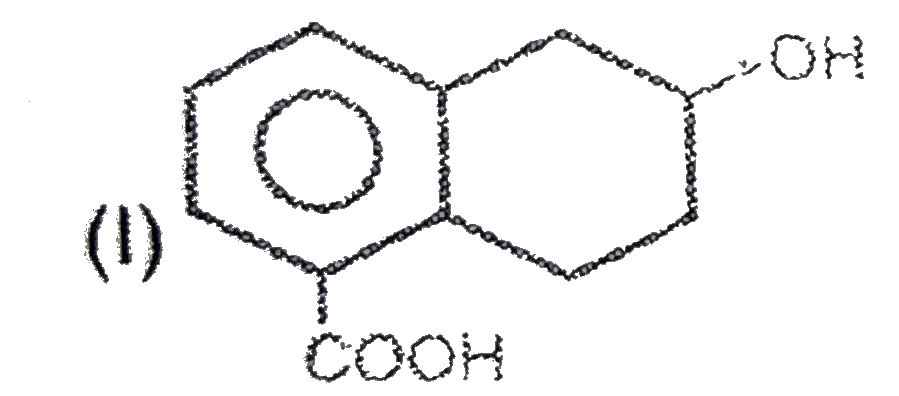The following two compounds I and II can be distinguished by using reagent

(a) aq. NaHCO3 (b) Neutral FeCl3
(c) Blue litmus solution (d) Na metal
(e) HCl/ZnCl2 anhydrous
a or c
b or e
d or e
c or d
The correct Answer is:B
Topper's Solved these Questions
- STRUCTURAL IDENTIFICATION & PRACTICAL ORGANIC CHEMISTRYBOOK - RESONANCECHAPTER - STRUCTURAL IDENTIFICATION & PRACTICAL ORGANIC CHEMISTRYEXERCISE - Section-E
8 Videos
- STRUCTURAL IDENTIFICATION & PRACTICAL ORGANIC CHEMISTRYBOOK - RESONANCECHAPTER - STRUCTURAL IDENTIFICATION & PRACTICAL ORGANIC CHEMISTRYEXERCISE - Part-III Match the column
2 Videos
- STRUCTURAL IDENTIFICATION & PRACTICAL ORGANIC CHEMISTRYBOOK - RESONANCECHAPTER - STRUCTURAL IDENTIFICATION & PRACTICAL ORGANIC CHEMISTRYEXERCISE - Section-C
6 Videos
- SOLID STATEBOOK - RESONANCECHAPTER - SOLID STATEEXERCISE - Part- IV
22 Videos
- THERMODYNAMIC & THERMOCHEMISTRYBOOK - RESONANCECHAPTER - THERMODYNAMIC & THERMOCHEMISTRYEXERCISE - PHYSICAL CHEMITRY (THERMODYNAMIC & THERMOCHEMISTRY)
62 Videos
Similar Questions
The following two compounds I and II can be distinguished by using reagent
 " "
" " 
(a) aq. NaHCO3 " " (b) Neutral FeCl3
(c ) Blue litmus solution " " Na metal " " (e) HCl/ZnCl2 anhydrous
View SolutionThe following two compounds I and II can be distinguished by using reagent

(a) aq. NaHCO3 , Neutral FeCl3
(b) Blue litmus solution , Na metal
(c) HCl/ZnCl2 anhydrous
View Solution
Knowledge Check
The following two compounds I and II can be distinguished by using reagent
 " "
" " 
(a) aq. NaHCO3 " " (b) Neutral FeCl3
(c ) Blue litmus solution " " Na metal " " (e) HCl/ZnCl2 anhydrousAa or cBb or eCd or eDc or dThe following two compounds I and II can be distinguished by using reagent

(a) aq. NaHCO3 " " (b) Neutral FeCl3
(c ) Fehling solution " " (d) Na metalAa or cBb or cCc or dDb ro dThe following two conpound I and II can be distinguished by using reagent:

(p) aq. NaHCO3 ltBrgt (Q) Nerutral FeCl3
( R ) blue litmus solution
(S) Na metal
(T) HCL/ZnCl2anhydrousAP or RBQ or TCS or TDR or S
The following two compounds I and II can be distinguished by using reagent

(1)Aq.NaHCO3 , (2)Neutral FeCl3(aq.)(FeCl3+NH4OH+H2O)
(3)Blue litmus solution , (4)Na metal
(5)HCl+ZnCl2(anhydrous)
View SolutionThe following two compounds I and II can be distinguished by using reagent

(1)Aq.NaHCO3 , (2)Neutral FeCl3(aq.)(FeCl3+NH4OH+H2O)
(3)Blue litmus solution , (4)Na metal
(5)HCl+ZnCl2(anhydrous)
View SolutionAcetaldehyde and propyne can be distinguish by
(i) Tollen's reagent (ii) I2/NaOH (iii) Lucas reagent (iv) neutral FeCl3
View SolutionCompounds I and II can be distinguished by using reagent.
(I) -4-Amino-2-methylbut-3-en-ol
(II) -4-Amino-2,2dimethylbut-3-yn-1-ol
View SolutionAcetaldehyde and Propyne can be distinguish by :
(i) Tollen's reagent " " (ii) l2/NaOH " " (iii) Lucas reagent " " (iv) neutral FeCl3
View Solution
